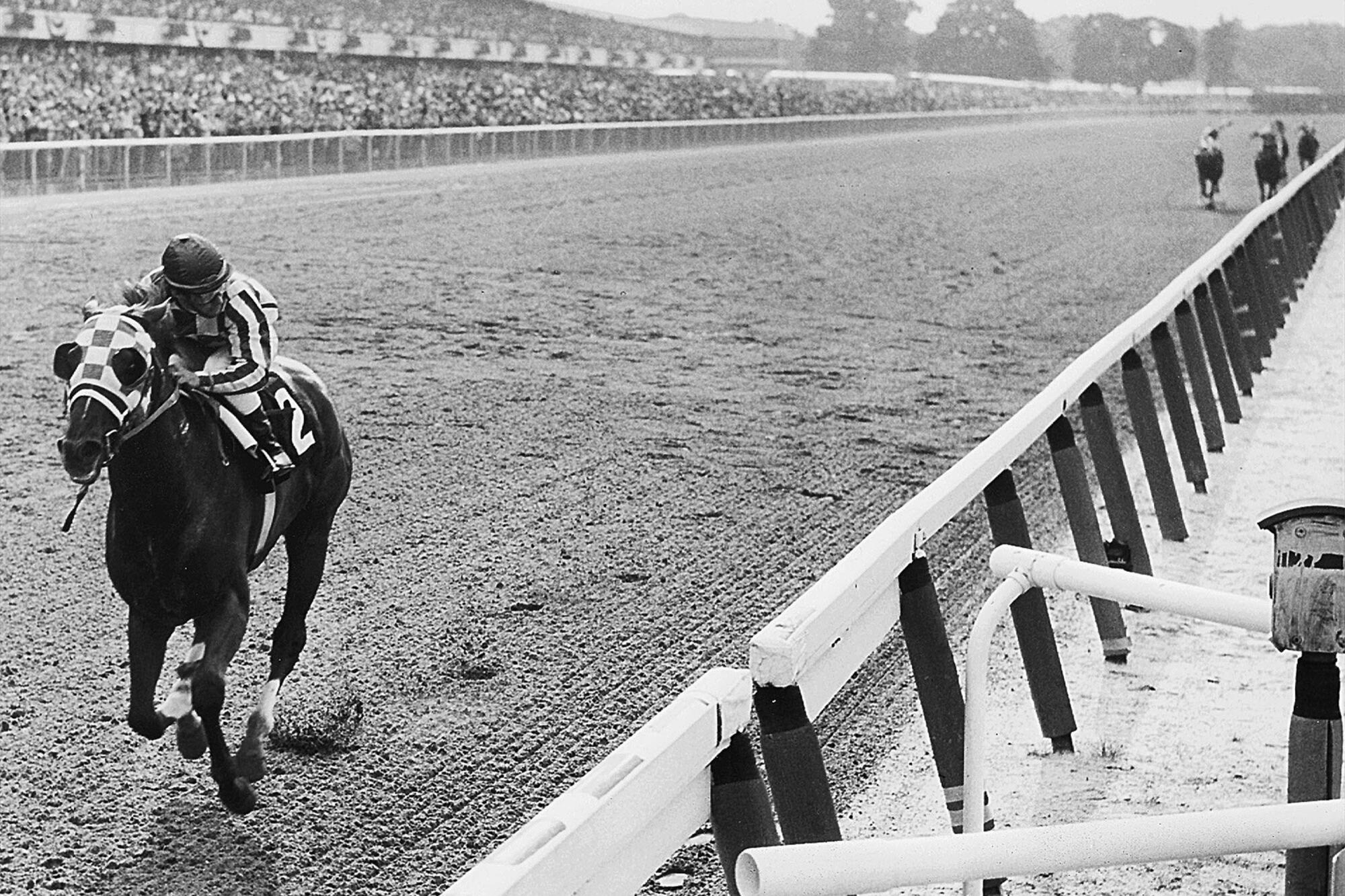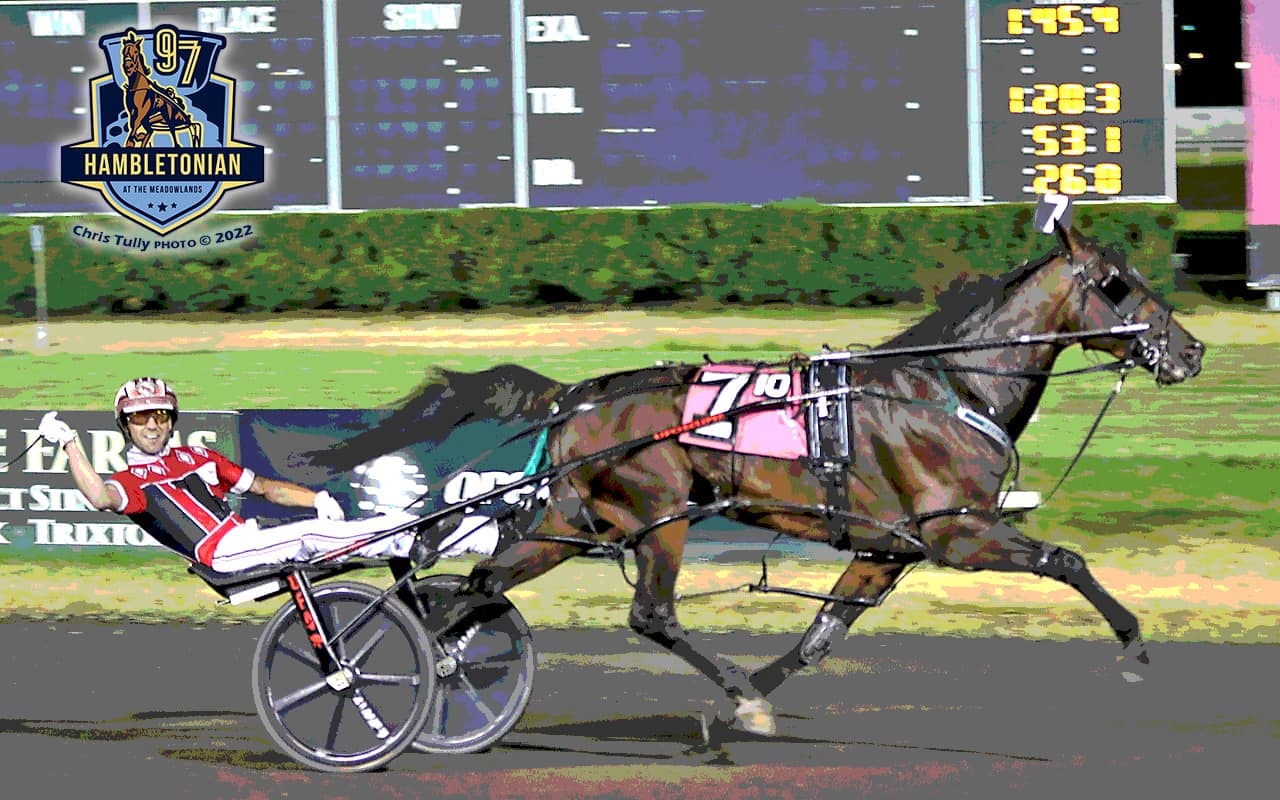IT’S TIME!
“TIME” has so many meanings that it would take many, many Mane Attraction columns to define them all.
In harness racing, though, “TIME” is the king.
 From the first recorded sub-3:00 mile by Yankee in 1806 to Star Pointer’s first recorded sub-2:00 mile in 1897 to Dan Patch’s 1:55 1/4 mile in 1905 (his 1:55 mile disallowed using a windshield) to Billy Direct’s 1:55 mile 33 years later…TIME has been the king!
From the first recorded sub-3:00 mile by Yankee in 1806 to Star Pointer’s first recorded sub-2:00 mile in 1897 to Dan Patch’s 1:55 1/4 mile in 1905 (his 1:55 mile disallowed using a windshield) to Billy Direct’s 1:55 mile 33 years later…TIME has been the king!
As our grand breed began to chip away at the hypnotizing phenomena known as TIME—these days by a fifth-of-a-second—we approach a once thought unapproachable mark of 1:45.
It’s just been an amazing TIME in our sport that, still, a few have witnessed as the last 9 1/5 seconds, or 46 lengths—have evaporated into our current world record TIME in our era of life.
It’s almost the same as when we honor the last surviving World War II heroes of that comparable era.
Possibly even more impressive is the TIME for our two-year-olds, still years away from their anatomy becoming fully and muscularly developed for optimum performance.
When I first became enamored by harness racing, the 2:10 two-year-old list was sacred and, when I was just a little tyke, a two-year-old had never pierced the 2:00 mark on any size track with Knight Dream the closest at 2:00 2/5 in 1947d
Heck, the immortal Adios had the fastest TIME on a half-miler at 2:03 3/4—yeah, they still timed races in quarter-seconds back then.
Today, TIME is a friend to a few and, quite possibly, an enemy of the masses.
It means everything to the breeder and nothing to the bettor with his $2 to win on some horse’s nose—or, in charted terms, “ns.”
Yes, the bettor has been forgotten by this breed and that is a shame!
Most businesses need patrons to survive…after all, a restaurant can’t survive without them, sports teams can’t survive without them…the hundreds of thousands of business owners on the internet can’t survive without them…but, because of casino money and some legislatures, harness racing thinks it can!
But let me get back on “track.”
Sippinonsearoc (Downbytheseaside) recently became the fastest two-year-old in history with his 1:48.2 scintillating performance at The Red Mile…1:48.2.

Now two-year-old speed is really nothing new in our sport and I consider the beginning of this trend began at the “Pomp” way back in 1990 when Artsplace performed the miracle mile time of 1:51.1 over their five-eighths mile track, leaving all the other two-year-old records on mile tracks in the top 10 in the dust.
The gelding Sheer Desire joined the sub-1:50 list at The Red Mile in 2008 to become a record holder for his age, gait and sex (he’s off the top 50 list these days) as One More Laugh “clipped” (yes, a gelding) a fifth-of-a-second off that mark the next year with a 1:49.2 mile, as well.
It’s took some time for Sippinonsearoc to get to the top of the list with, first, the filly Warrawee Upbeat (1:48.3) then taking the top spot in 2018, followed by the gelded Elver Hanover the next season and these two were joined by Caviart Camden in 2021 before Sippinonsearoc soared to the top just days ago.
Of course, we cannot forget Pebble Beach in 2021, Test Of Faith in 2020 and Twin Be Joe Fresh 2022, still going amazingly strong, with their 1:48.4 performances over the recent years.
As stated before, any mile “slower” than 1:49.2 isn’t in the top 50 list—an amazing transformation to a breed formerly known for its durability.
Just how did this happen?
Several have chimed in with Steve Ross pointing out that “Sippin’s” time would have beaten the time of the great Albatross by 35 lengths—or, as Steve pointed out, “or Bret Hanover, or Niatross, or whomever else-for that matter.
Steve also pointed out that, “conversely, Secretariat, who raced around the same time as Albatross, still holds the track records for ALL THREE TRIPLE CROWN RACES…from 51 years ago!

“Not Seattle Slew…not Affirmed…not American Pharaoh…Not Justify…NO ONE!”
Diane Stampalia chimed in saying, “apart from genetics of the best being available to any breeder, improved equipment and animal husbandry, there has been huge progress with track design and composition.
She points out the metro track in Western Australia, for example, which is 804 meters, and exceptional horses including King Of Swing rated 1:52.7 but on the 1400 meter Menangle (NSW) track, he won his last race in 1:47.9.
Aussie Ian Glading asks, “Why is America so obsessed with speed?
“Nowhere on earth is speed obsessed like the Americans. If we win a big race in Australia or New Zealand, nobody really cares about the race time. Sure, it might get a mention if the time is exceptional but, overall, we just want to win the race…and don’t care if it takes a half-an-hour!”
Todd Beelby then reminds, “Cambest, 31 years ago, TT1:46.1.
Susan Sala Traska told of her cousin taking care of Cambest and reminding that “old school grooming…you know, walking after they train three trips or a double header with the last trip in the bike doing them up. Remember those days? (LOL)
And lest we forget the great Bulldog Hanover and his amazing miles and becoming the first standardbred horse ever to break the 1:46 barrier with his 1:45.4 mile at the Meadowlands in $500,000 Haughton Memorial on July 16, 2022.

Butch Dant has some valid input saying, “If you made every thoroughbred race one mile and on the dirt, you would definitely see the mile record broken. All the training and breeding would be focused on that…and only that!
“There would be no more turf champions or sprinters. All the best horses would be getting better and better at that one mile distance. That’s what happened in harness racing.”
(Actually, in Kiwi land, they do race at different distances—from a mile to two miles, with Chad Morrison pointing out that breeding is much more refined, and gait is “so much better now!”)
It’s also been pointed out that the great t-bred horse Dr. Fager set a world record for a mile back in 1968—56 years ago—at 1:32 1/5. It’s still the record to this very day.
Steve Ross points out that, in that same era when Bret Hanover was around, he set a world record of 1:53.3, which will get you, as Gil Winston points out, bupkis, these days!
John Hochstetler joined the fray saying, “race bikes are half the weight and underslung. Knee boots and leather harnesses were heavier, so equipment has evolved. Track surfaces (have improved)”
Oscar Belliveau says the standardbred breed is still evolving and hasn’t reached its limit.
Dave Krepow reminds us that “you have to look at every (aspect) from breeding to shoeing to lightweight equipment (and) driving styles…even the design and material that make up sulkies are a part of the equation.”
My friend Mike White said “artificial insemination has enabled the breed to advance much faster than the thoroughbred breed, which still has natural cover. Stallions are able to cover many more mares, and the best sites can dominate the gene pool.”
But Heather Reese-Marshall says that the “TBs” are allowed to cover more mares in a season than the Standardbred stallions…with Elizabeth Yontz agreeing.
Julie Roberts has contributed the following: Secretariat, Sham and Australia’s Phar Lap had one thing in common…the “X” factor game that causes a larger heart.
She says, “The average horse’s heart is between eight and 10 pounds. Secretariat’s hearts weighed 22+ pounds, Sham’s heart was 18 pounds and Phar Lap’s 14 pounds.
“Their horses had bigger power plants.”
Comparing harness racing to the thoroughbred sport, Julie lamented, “I love the great Greyhound. To me, Greyhound to harness racing during his time was what Man O’ War was to the thoroughbred racing…and Niatross was to harness racing was to Secretariat in thoroughbred racing. They’re all different but that is what makes it great!”
Jeff Thomas chimed in saying, “Bill O’Donnell says the tracks are all like a highway now. I’ll stick with him!”
Ellie Sarama sees two very distinct differences…”Many years ago, our breed was known as jug heads and for good reason. The difference in their skeletal make up has become so refined from yesteryear until today that they look like an entirely different breed.
“Next, the equipment has evolved from heavy leather to light beta material. Aerodynamic sulkies and wheels that accommodate speed. Racing surfaces and hub-less rails with banked turns adds to the speed factor.”
Blair Burgess has some very valid input saying, “We have refined the breed out of necessity to stay competitive with each other. We race over faster, harder racetracks with more banks in turns. Finally, the removal of the hub rails definitely shortened races. Even if the tracks measure the same, the drivers definitely take greater chances and ride closer to the pylons. Riding close to the solid rail was much more dangerous.
“Human track athletes have also improved: advances training methods, better tracks, better nutrition, better shoes and accidental genetics. Human race is faster and stronger.”
Roger Bannister was the first human to crack the 4:00 mile and, today, the record is 3:43.13—a record that has stood the test of TIME for 25 years!
To settle this TIME question and the explosion in speed, This Mane Attraction closes with an interesting suggestion for those that love our sport.
Back in 1968, the greatest names in our sport covering all aspects of harness racing…Billy Haughton, Stanley Dancer, Delvin Miller, Ralph Baldwin, John Simpson, Sr., Frank Ervin, Joe O’Brien, Bob Farrington, Harry Pownall, Curly Smart, Sanders Russell, New Zealand’s George Noble, Harry Harvey, James Harrison, Dr. William Churchill and Dr. William Tyznik each contributed their expertise on subject matter ranging from Bloodlines, yearling selection, training and conditioning, shoeing, equipment, running and managing stable, driving, care of the horse, lameness and nutrition.
TIMES have changed since then, in many ways, and it’s time some of our great horsemen and women of our era do the same.
May The Horse Be With You!
by John Berry, for Harnesslink

 USA
USA Canada
Canada Australia
Australia New Zealand
New Zealand Europe
Europe UK / IRE
UK / IRE



